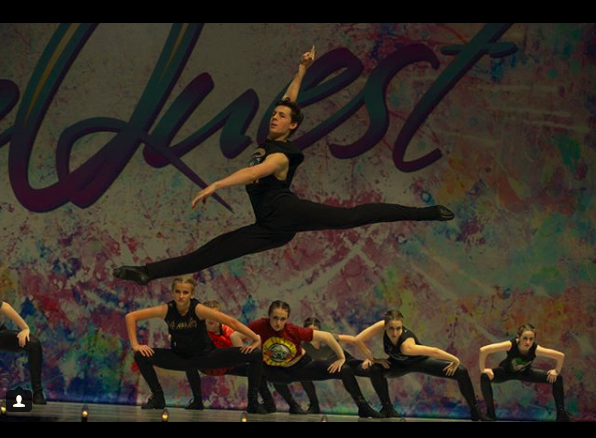The Life of a Dancer — Louis Zimmermann

May 14, 2018
Twenty hours, six styles, 12 classes and 6 out of 7 days. In a nutshell of numbers, this is what my week consists of as a competitive dancer. And this routine starts in September and ends in June. Because of this immense training and energy I put into dance, I cannot stand by hearing another person exclaim that dance is not a sport.
Starting dance at a young age, I took one class and was at the studio for a whopping hour each week. As I’ve grown older and my passion for dance has intensified, I have added dance classes to my rapidly growing list allowing me to practically live at the studio. With this, however, came immense dedication and a lot of physical training on my body. I soon had to start stretching my feet while doing homework, improve my technique in ballet class, concentrate on making my tap sounds louder by being grounded, use strength to be agile while practicing contemporary dance, incorporate theatrical components into jazz class and increase my overall confidence during hip hop dances. As all of that sentence is a mouthful, dance is a handful of work and effort.
I frequently get the generic question, “Do you play any sports?” When my answer that follows is dance, I often get confused stares that are quickly covered up by another generic question. It is evident that most see dance as an artform. And I can only agree with that. However, that does not limit its ability to be seen as a sport, even if scoreboards and nets are not necessarily involved.
As other dancers would attest to, the training can be excruciatingly painful, holding your leg in the air for two long counts of eight or having a dance instructor force your body to hold an oversplit for five minutes. The training for dance is evidently unlike training for football, basketball, baseball, soccer, or any other sport; however, the physical attributes behind dancing (improving stamina, strength and skill) are all congruent to those of other sports. The amount of physical strain placed on a dancers body equates or surpasses that of other athletes. To compare dancers to football players, 80 percent of dancers incur at least one injury a year compared to a 20 percent of football players.
The pure physicality of most committed dancers should in and of itself eliminate the wavering question of whether or not dance is a sport. Simply perform an easy Google search of Misty Copeland and see for yourself that dance trains every muscle in one’s body, and all of these muscles are constantly engaged while performing on stage. Dancers must think of the muscles in their feet that help them perfect their point, their leg muscles that help them attain the highest jump and their core muscles that keep them on balance.
The world has painted dance in a dim light of ballerina boxes, tutus and intricate costumes. Although spectators may only see the final result travel across an illuminated stage, the process of attaining a performance stretches far past learning choreography into countless hours of work, sweat and improvement. It is time to eliminate the fixed mindset of dance being simply an art to stop undermining the athleticism of dancers.







